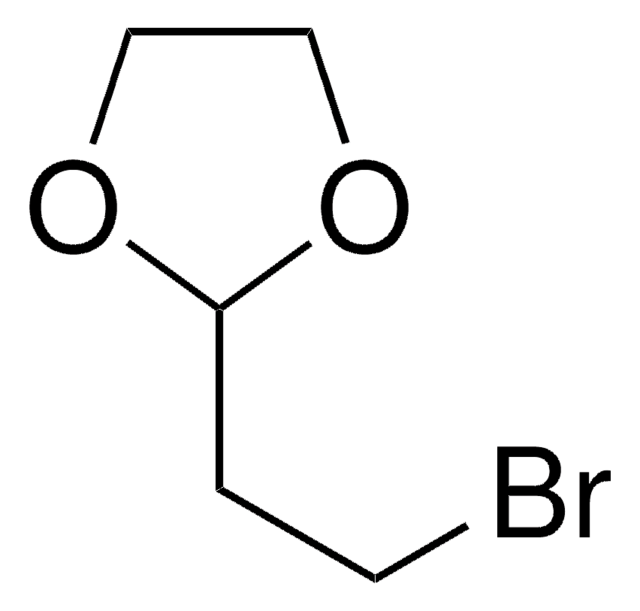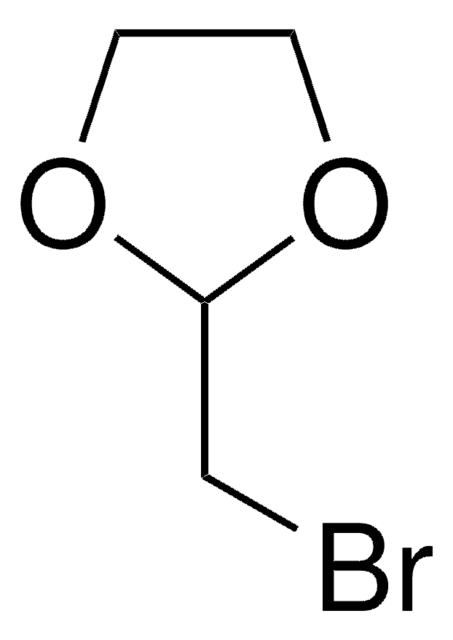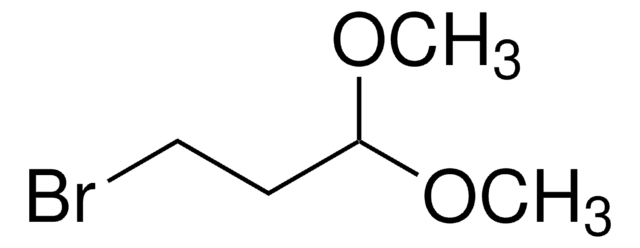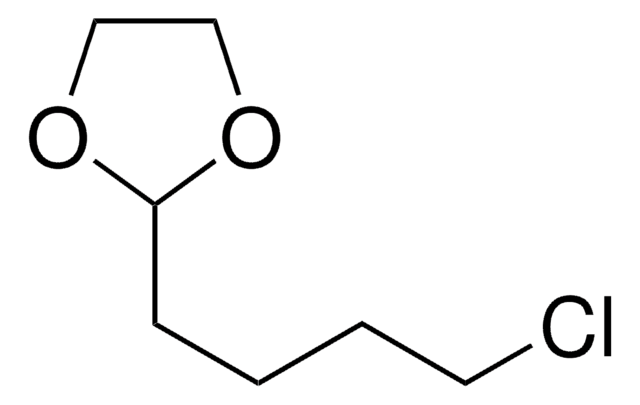Wszystkie zdjęcia(1)
Kluczowe dokumenty
26235
2-(3-Chloropropyl)-1,3-dioxolane
≥97.0% (GC)
Synonim(y):
4-Chlorobutyraldehyde ethylene acetal
Zaloguj sięWyświetlanie cen organizacyjnych i kontraktowych
About This Item
Wzór empiryczny (zapis Hilla):
C6H11ClO2
Numer CAS:
Masa cząsteczkowa:
150.60
Beilstein:
1236588
Numer MDL:
Kod UNSPSC:
12352100
Identyfikator substancji w PubChem:
NACRES:
NA.22
Polecane produkty
Poziom jakości
Próba
≥97.0% (GC)
Formularz
liquid
współczynnik refrakcji
n20/D 1.453
bp
93-94 °C/12 mmHg (lit.)
gęstość
1.142 g/mL at 20 °C (lit.)
grupa funkcyjna
chloro
ether
ciąg SMILES
ClCCCC1OCCO1
InChI
1S/C6H11ClO2/c7-3-1-2-6-8-4-5-9-6/h6H,1-5H2
Klucz InChI
ZBPUNVFDQXYNDY-UHFFFAOYSA-N
Powiązane kategorie
Zastosowanie
2-(3-chloropropylo)-1,3-dioksolan (2-(3′-chloropropylo)-1,3-dioksolan) jest zamaskowanym γ-chlorobutyraldehydem i został użyty do wprowadzenia grupy 3-(1,3-dioksolan-2-ylo)propylu. Został on również wykorzystany w syntezie:
- (±)-histrionikotoksyny i (±)-histrionikotoksyny 235A przy użyciu strategii dwukierunkowej
- 4-jodobutyraldehyd, 5-jodowaleraldehyd i 5-jodo-2-petanon
- odpowiedni fosfonian
Inne uwagi
Masked γ-chlorobutyraldehyde, useful for the introduction of the 3-(1,3-dioxolan-2-yl)propyl moiety; Preparation and use of the corresponding phosphonate
Ta strona może zawierać tekst przetłumaczony maszynowo.
Kod klasy składowania
10 - Combustible liquids
Klasa zagrożenia wodnego (WGK)
WGK 3
Temperatura zapłonu (°F)
174.2 °F - closed cup
Temperatura zapłonu (°C)
79 °C - closed cup
Środki ochrony indywidualnej
Eyeshields, Gloves, type ABEK (EN14387) respirator filter
Wybierz jedną z najnowszych wersji:
Masz już ten produkt?
Dokumenty związane z niedawno zakupionymi produktami zostały zamieszczone w Bibliotece dokumentów.
C.P. Forbes et al.
Journal of the Chemical Society. Perkin Transactions 1, 2353-2353 (1977)
Two-directional synthesis. Part 1: A short formal synthesis of (?)-histrionicotoxin and (?)-histrionicotoxin 235A.
Stockman RA.
Tetrahedron Letters, 41(47), 9163-9165 (2000)
S.A. Bal et al.
The Journal of Organic Chemistry, 47, 5045-5045 (1982)
R.E. Abbott et al.
The Journal of Organic Chemistry, 45, 5398-5398 (1980)
A Nagy et al.
Proceedings of the National Academy of Sciences of the United States of America, 93(6), 2464-2469 (1996-03-19)
A convenient, high yield conversion of doxorubicin to 3'-deamino-3'-(2''-pyrroline-1''-yl)doxorubicin is described. This daunosamine-modified analog of doxorubicin is 500-1000 times more active in vitro than doxorubicin. The conversion is effected by using a 30-fold excess of 4-iodobutyraldehyde in anhydrous dimethylformamide. The
Nasz zespół naukowców ma doświadczenie we wszystkich obszarach badań, w tym w naukach przyrodniczych, materiałoznawstwie, syntezie chemicznej, chromatografii, analityce i wielu innych dziedzinach.
Skontaktuj się z zespołem ds. pomocy technicznej








